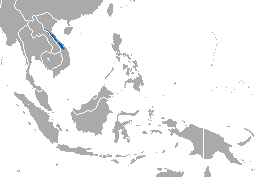Related Research Articles

Rabbits are small mammals in the family Leporidae, which is in the order Lagomorpha. The European rabbit, Oryctolagus cuniculus is the ancestor of the world's hundreds of breeds of domestic rabbit. Sylvilagus includes 13 wild rabbit species, among them the seven types of cottontail. The European rabbit, which has been introduced on every continent except Antarctica, is familiar throughout the world as a wild prey animal, a domesticated form of livestock and a pet. With its widespread effect on ecologies and cultures, in many areas of the world, the rabbit is a part of daily life – as food, clothing, a companion, and a source of artistic inspiration.

The lagomorphs are the members of the taxonomic order Lagomorpha, of which there are two living families: the Leporidae and the Ochotonidae (pikas). There are 110 recent species of lagomorph of which 109 are extant, including 10 genera of rabbits, 1 genus of hare and 1 genus of pika. The name of the order is derived from the Ancient Greek lagos + morphē.

Leporidae is the family of rabbits and hares, containing over 70 species of extant mammals in all. The Latin word Leporidae means "those that resemble lepus" (hare). Together with the pikas, the Leporidae constitute the mammalian order Lagomorpha. Leporidae differ from pikas in that they have short, furry tails and elongated ears and hind legs.

The saola, also called spindlehorn, Asian unicorn, or infrequently, Vu Quang bovid, is one of the world's rarest large mammals, a forest-dwelling bovine native to the Annamite Range in Vietnam and Laos. It was described in 1993 following a discovery of remains in Vũ Quang National Park by a joint survey of the Vietnamese Ministry of Forestry and the World Wide Fund for Nature. Saolas have since been kept in captivity multiple times, although only for short periods as they died within a matter of weeks to months. The species was first reported in 1992 by Do Tuoc, a forest ecologist, and his associates. The first photograph of a living saola was taken in captivity in 1993. The most recent one was taken in 2013 by a movement-triggered camera in the forest of central Vietnam. It is the only species in the genus Pseudoryx.

The common tapeti, also known as the Brazilian cottontail, forest cottontail, or (formerly) simply tapeti is a species of cottontail rabbit. It is small to medium-sized with a small, dark tail, short hind feet, and short ears. As traditionally defined, its range extends from southern Mexico to northern Argentina, but this includes several distinctive population that have since been split into separate species. Under this narrower definition, the true common tapeti only occurs in the Atlantic Rainforest of coastal northeastern Brazil and it is classified as "Endangered" by the IUCN. The American Society of Mammalogists concurs, but also tentatively classifies several distinct populations that have not yet received proper species names into S. brasiliensis, and thus considers it to range from Venezuela south to Argentina.

The Sumatran striped rabbit, also known as the Sumatra short-eared rabbit or Sumatran rabbit, is a rabbit found only in forests in the Barisan Mountains in western Sumatra, Indonesia, and surrounding areas. It is threatened by habitat loss.

The Annamite striped rabbit is a species of rabbit native to the Annamite mountain range on the Laos-Vietnam border. The rabbit is striped, with a red rump, and resembles the Sumatran striped rabbit. It only recently became known to Western scientists: striped rabbits were first observed in 1996 by biologist Rob Timmins in a market in Bak Lak in Laos, and the species was described in 2000 and named after Timmins' find.

Indo-Burma is a biodiversity hotspot designated by Conservation International.

The wildlife of Laos encompasses the animals and plants found in the Lao People's Democratic Republic, a landlocked country in southeastern Asia. Part of the country is mountainous and much of it is still clad in tropical broadleaf forest. It has a great variety of animal and plant species.

The Mexican cottontail is a species of cottontail rabbit in the family Leporidae. It is endemic to Mexico where its natural habitats are temperate forests, subtropical or tropical dry forests and pastureland.

Dice's cottontail is a species of cottontail rabbit in the family Leporidae. It is found in Costa Rica and Panama, in páramo and cloud forest habitats.
The marsh rabbit is a small cottontail rabbit found in marshes and swamps of coastal regions of the Eastern and Southern United States. It is a strong swimmer and found only near regions of water. It is similar in appearance to the eastern cottontail but is characterized by smaller ears, legs, and tail.

Pù Mát National Park is a national park in Nghệ An Province, in Vietnam's North Central Coast region. It is part of the Western Nghệ An Biosphere Reserve.
Nakai-Nam Theun National Park in Nakai District, Khammouane Province, Laos, is one of the last remaining wildernesses in Southeast Asia. Nakai-Nam Theun covers approximately 4,270 km2 of the Annamite Range and the adjacent Nakai Plateau in Khammouane and Bolikhamsai Provinces. It was designated a national park on 15 February 2019 by Prime Ministerial Decree No. 36, 15 February 2019. It is managed by the Ministry of Agriculture and Forestry (MAF). It is adjacent to the Vu Quang National Park of Vietnam.

Nesolagus is a genus of rabbits containing three species of striped rabbit: the Annamite striped rabbit, the Sumatran striped rabbit, and the extinct species N. sinensis. Overall there is very little known about the genus as a whole, most information coming from the Sumatran rabbit.

The Venezuelan lowland rabbit, also known as the Barinas wild rabbit, is a cottontail rabbit species found in western Venezuela.

The Suriname tapeti or Suriname lowland forest cottontail is a South American species of cottontail rabbit described in 2017. It is known from the lowlands of western Suriname, and was described from specimens collected by Dutch scientists in the 1980s. Its size is relatively large for a South American cottontail rabbit. The rabbit is likely already threatened due to environmental degradation in the region, and its discovery could boost conservation efforts in the area. It was discovered by Portland State University Professor Luis Ruedas.
References
- ↑ Durant, Pedro; Guevara, Manuel A. (March 2001). "A new rabbit species (sylvilagus, Mammalia: leporidae) from the lowlands of venezuela". Revista de Biología Tropical. 49 (1): 369–381. hdl:10669/26556. PMID 11795167.
- ↑ "Nesolagus timminsi". IUCN Red List. Retrieved 2006-06-27.